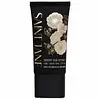Beauty of Joseon Daily Tinted Fluid Sunscreen SPF 40 Versus Saint Jane Luxury Sun Ritual Pore Smoothing Face Sunscreen SPF 30
What's inside
What's inside
 Key Ingredients
Key Ingredients

 Benefits
Benefits

 Concerns
Concerns

 Ingredients Side-by-side
Ingredients Side-by-side

Zinc Oxide
Cosmetic ColorantWater
Skin ConditioningButyloctyl Salicylate
Skin ConditioningIsopropyl Myristate
EmollientCoco-Caprylate/Caprate
EmollientCaprylic/Capric Triglyceride
MaskingNeopentyl Glycol Diheptanoate
EmollientEthylhexyl Isononanoate
EmollientAlcohol Denat.
AntimicrobialPolyglyceryl-3 Polyricinoleate
EmulsifyingButylene Glycol
HumectantC12-15 Alkyl Benzoate
AntimicrobialPropanediol
SolventSilica
AbrasiveMethyl Methacrylate Crosspolymer
Stearic Acid
CleansingPolyglyceryl-6 Polyhydroxystearate
EmulsifyingHydrogenated Olive Oil Unsaponifiables
EmollientArtemisia Capillaris Extract
Polyglyceryl-4 Diisostearate/Polyhydroxystearate/Sebacate
EmulsifyingStearalkonium Hectorite
Gel FormingUndecane
Emollient1,2-Hexanediol
Skin ConditioningPolyglyceryl-6 Polyricinoleate
EmulsifyingHydroxyacetophenone
AntioxidantTridecane
PerfumingPolyglycerin-6
HumectantIsopropyl Titanium Triisostearate
EmollientTocopherol
AntioxidantAscorbyl Palmitate
AntioxidantCI 77492
Cosmetic ColorantCI 77491
Cosmetic ColorantCI 77499
Cosmetic ColorantZinc Oxide, Water, Butyloctyl Salicylate, Isopropyl Myristate, Coco-Caprylate/Caprate, Caprylic/Capric Triglyceride, Neopentyl Glycol Diheptanoate, Ethylhexyl Isononanoate, Alcohol Denat., Polyglyceryl-3 Polyricinoleate, Butylene Glycol, C12-15 Alkyl Benzoate, Propanediol, Silica, Methyl Methacrylate Crosspolymer, Stearic Acid, Polyglyceryl-6 Polyhydroxystearate, Hydrogenated Olive Oil Unsaponifiables, Artemisia Capillaris Extract, Polyglyceryl-4 Diisostearate/Polyhydroxystearate/Sebacate, Stearalkonium Hectorite, Undecane, 1,2-Hexanediol, Polyglyceryl-6 Polyricinoleate, Hydroxyacetophenone, Tridecane, Polyglycerin-6, Isopropyl Titanium Triisostearate, Tocopherol, Ascorbyl Palmitate, CI 77492, CI 77491, CI 77499
Zinc Oxide 10%
Cosmetic ColorantWater
Skin ConditioningButylene Glycol
HumectantCaprylic/Capric Triglyceride
MaskingDimethicone
EmollientCetearyl Alcohol
EmollientCetearyl Olivate
Polyglyceryl-3 Diisostearate
EmulsifyingSorbitan Olivate
EmulsifyingJasminum Officinale Extract
MaskingHibiscus Sabdariffa Flower Extract
Skin ConditioningAdenium Obesum Callus Culture Extract
AntioxidantCetearyl Glucoside
EmulsifyingTriethoxycaprylylsilane
Camellia Sinensis Leaf Oil
AntioxidantTocopheryl Acetate
AntioxidantXanthan Gum
EmulsifyingPhenoxyethanol
PreservativeEthylhexylglycerin
Skin ConditioningIron Oxides
Zinc Oxide 10%, Water, Butylene Glycol, Caprylic/Capric Triglyceride, Dimethicone, Cetearyl Alcohol, Cetearyl Olivate, Polyglyceryl-3 Diisostearate, Sorbitan Olivate, Jasminum Officinale Extract, Hibiscus Sabdariffa Flower Extract, Adenium Obesum Callus Culture Extract, Cetearyl Glucoside, Triethoxycaprylylsilane, Camellia Sinensis Leaf Oil, Tocopheryl Acetate, Xanthan Gum, Phenoxyethanol, Ethylhexylglycerin, Iron Oxides
 Reviews
Reviews

Ingredients Explained
These ingredients are found in both products.
Ingredients higher up in an ingredient list are typically present in a larger amount.
Butylene Glycol (or BG) is used within cosmetic products for a few different reasons:
Overall, Butylene Glycol is a safe and well-rounded ingredient that works well with other ingredients.
Though this ingredient works well with most skin types, some people with sensitive skin may experience a reaction such as allergic rashes, closed comedones, or itchiness.
Learn more about Butylene GlycolThis ingredient is an emollient, solvent, and texture enhancer. It is considered a skin-softener by helping the skin prevent moisture loss.
It helps thicken a product's formula and makes it easier to spread by dissolving clumping compounds.
Caprylic Triglyceride is made by combining glycerin with coconut oil, forming a clear liquid.
While there is an assumption Caprylic Triglyceride can clog pores due to it being derived from coconut oil, there is no research supporting this.
Learn more about Caprylic/Capric TriglycerideWater. It's the most common cosmetic ingredient of all. You'll usually see it at the top of ingredient lists, meaning that it makes up the largest part of the product.
So why is it so popular? Water most often acts as a solvent - this means that it helps dissolve other ingredients into the formulation.
You'll also recognize water as that liquid we all need to stay alive. If you see this, drink a glass of water. Stay hydrated!
Learn more about WaterZinc Oxide is a mineral broad-spectrum UV filter; it is the broadest UVA and UVB reflector approved by the FDA. It also has skin protectant and skin soothing properties.
Zinc oxide is one of the most effective broad-spectrum UV filters. It protects against UVB, UVAII, and UVAI. In comparison to its counterpart titanium dioxide, zinc oxide provides uniform and extended UVA protection.
Another great benefit? This ingredient is highly photostable so it won't degrade easily under sunlight.
A common myth is that mineral UV filters are widely believed to primarily reflect UV light.
However, modern research shows titanium dioxide absorbs UV radiation like chemical filters (~95% absorption & 5% reflection).
Zinc oxide has great skin soothing properties so you'll likely find this in sunscreens formulated for sensitive skin or babies/children. It is unlikely to cause "eye sting" like other sunscreen ingredients.
Regulatory agencies consider zinc oxide to be non-toxic and safe. It has also been shown to not penetrate the skin.
Unfortunately, this ingredient does leave a visible white cast. This is why mineral sunscreens are often less cosmetically elegant than chemical or hybrid ones.
In cosmetics, zinc oxide can be found in both non-nano and nano-sized forms. The nano version is used to reduce white cast and improve the texture of sunscreen formulas.
There are ongoing concerns surrounding nano-zinc oxide's impact on marine ecosystems and whether it can be absorbed into skin.
Regarding marine ecosystems and coral reefs, there is no conclusive evidence that any form of zinc oxide (or any other sunscreen ingredients) will cause harm. The science is still developing but many consumers are keeping a close eye on this issue.
Please note, many destinations have reef-safety sunscreen rules. For instance, the U.S. Virgin Islands advises all visitors to use non-nano mineral sunscreens.
There has also been some stir about whether micronized or nano zinc oxide has potential photoxicity and absorption through the skin/lungs.
An in-vitro (done in a test tube or petri dish) study demonstrated micronized zinc oxide to have potential phototoxicity. There's no need to fret; the EU Commission's Scientific Committee on Consumer Safety has stated, "The relevance of these findings needs to be clarified by appropriate investigations in vivo." Or in other words, further studies done on living organisms are needed to prove this.
Current research shows zinc oxide nanoparticles do not penetrate intact or sunburned skin. They either remain on the surface or in the outermost layer of dead skin (stratum corneum).
Zinc oxide is one of only two classified mineral UV filters with titanium dioxide being the other one.
Fun fact: Zinc has been used throughout history as an ingredient in paint and medicine. An Indian text from 500BC is believed to list zinc oxide as a salve for open wound. The Ancient Greek physician Dioscorides has also mentioned the use of zinc as an ointment in 1AD.
Learn more about Zinc Oxide